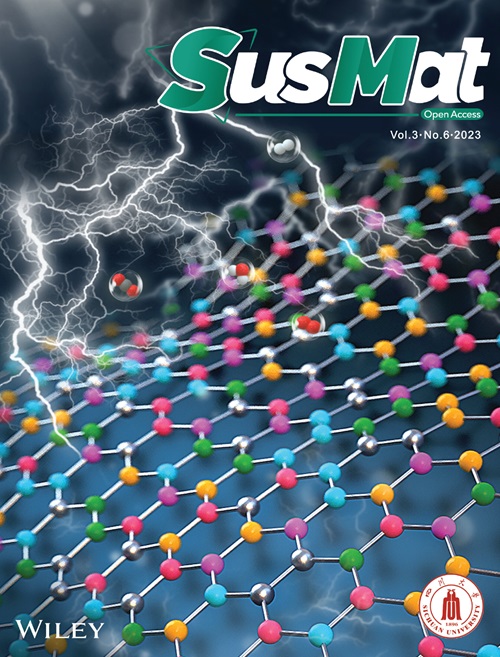Tungsten oxide‐anchored Ru clusters with electron‐rich and anti‐corrosive microenvironments for efficient and robust seawater splitting
IF 18.7
1区 材料科学
Q1 CHEMISTRY, MULTIDISCIPLINARY
引用次数: 0
Abstract
Abstract Ruthenium (Ru) has been recognized as a prospective candidate to substitute platinum catalysts in water‐splitting‐based hydrogen production. However, minimizing the Ru contents, optimizing the water dissociation energy of Ru sites, and enhancing the long‐term stability are extremely required, but still face a great challenge. Here, we report on creating tungsten oxide‐anchored Ru clusters (Ru–WO x ) with electron‐rich and anti‐corrosive microenvironments for efficient and robust seawater splitting. Benefiting from the abundant oxygen vacancy structure in tungsten oxide support, the Ru–WO x exhibits strong Ru–O and Ru–W bonds at the interface. Our study elucidates that the strong Ru–O bonds in Ru–WO x may accelerate the water dissociation kinetics, and the Ru–W bonds will lead to the strong metal–support interaction and electrons transfer from W to Ru. The optimal Ru–WO x catalysts exhibit a low overpotential of 29 and 218 mV at the current density of 10 mA cm −2 in alkaline and seawater media, respectively. The outstanding long‐term stability discloses that the Ru–WO x catalysts own efficient corrosion resistance in seawater electrolysis. We believe that this work offers new insights into the essential roles of electron‐rich and anti‐corrosive microenvironments in Ru‐based catalysts and provide a new pathway to design efficient and robust cathodes for seawater splitting.具有富电子和抗腐蚀微环境的氧化钨锚定Ru团簇,用于高效和强大的海水分裂
摘要钌(Ru)已被认为是替代铂催化剂在水裂解制氢中的潜在候选催化剂。然而,降低Ru含量,优化Ru位点的水解离能,提高长期稳定性是迫切需要的,但仍然面临着很大的挑战。在这里,我们报道了在富电子和抗腐蚀的微环境中创建氧化钨锚定的Ru团簇(Ru - wo x),用于高效和强大的海水分裂。得益于氧化钨载体中丰富的氧空位结构,Ru-WO - x在界面处表现出很强的Ru-O和Ru-W键。我们的研究表明,Ru - wo x中的强Ru - o键可能会加速水的解离动力学,而Ru - W键会导致强金属支撑相互作用和电子从W转移到Ru。在碱性介质和海水介质中,当电流密度为10 mA cm−2时,Ru-WO - x催化剂的过电位分别为29 mV和218 mV。优异的长期稳定性表明Ru-WO - x催化剂在海水电解中具有良好的耐腐蚀性。我们相信这项工作为富电子和抗腐蚀微环境在钌基催化剂中的重要作用提供了新的见解,并为设计高效和坚固的海水分裂阴极提供了新的途径。
本文章由计算机程序翻译,如有差异,请以英文原文为准。
求助全文
约1分钟内获得全文
求助全文
来源期刊
自引率
4.20%
发文量
0
期刊介绍:
SusMat aims to publish interdisciplinary and balanced research on sustainable development in various areas including materials science, engineering, chemistry, physics, and ecology. The journal focuses on sustainable materials and their impact on energy and the environment. The topics covered include environment-friendly materials, green catalysis, clean energy, and waste treatment and management. The readership includes materials scientists, engineers, chemists, physicists, energy and environment researchers, and policy makers. The journal is indexed in CAS, Current Contents, DOAJ, Science Citation Index Expanded, and Web of Science. The journal highly values innovative multidisciplinary research with wide impact.

 求助内容:
求助内容: 应助结果提醒方式:
应助结果提醒方式:


